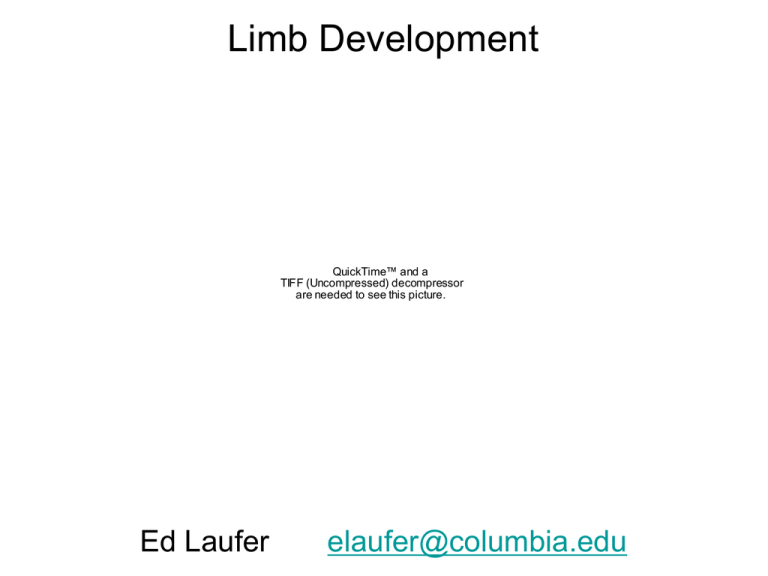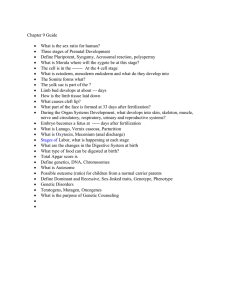Limb Development Ed Laufer QuickTime™ and a
advertisement

Limb Development QuickTime™ and a TIFF (Uncompressed) decompressor are needed to see this picture. Ed Laufer elaufer@columbia.edu What we will cover... QuickTime™ and a YUV420 codec decompressor are needed to see this picture. What signals control initiation of limb bud formation ? What signals transform the embryonic limb bud into a mature limb comprised of a precisely interconnected array of many different tissues? The developing limb is a model environment to study development QuickTime™ and a Photo - JPEG decompressor are needed to see this picture. QuickTime™ and a Photo - JPEG decompressor are needed to see this picture. cell fate specification - eg bone vs muscle vs tendon cell migration and pathfinding - muscle precursors, innervation QuickTime™ and a Photo - JPEG decompressor are needed to see this picture. cell proliferation/programmed cell death (apoptosis) - correct tissue morphology, interdigital cell death tissue patterning - organization of structures in 3D space limb abnormalities are associatedwith many human congenit EARLY LIMB PATTERNING: Forelimb bud Hindlimb bud Limb formation initiates during the fourth week of development (E9.0 in mouse) as the primary axis (AP) is still elongating. First the forelimb and then the hindlimb begin as protrusions from the lateral plate mesoderm at the sides of the embryo. Limb buds consist of a core of mesenchyme and an outer covering of ectoderm. 1 in 200 live human births display limb defects. Human Limb Development 5 weeks 6 weeks 8 weeks 5 weeks 6 weeks 8 weeks A-P (fingers); D-V (palm); P-D (length) Limbs rotate inward Day 33: hand plate, forearm, shoulder Day 37: Carpal region, digital plate Day 38: Finger rays, necrotic zones Day 44: toe rays Day 47: horizontal flexion Day 52: tactile pads Limb skeletal elements: Chicken Mouse Stylopod: The proximal element of a limb. The humerus in the forelimb and femur in the hindlimb Zeugopod:The intermediate element of a limb. The radius and ulna in the forelimb and the tibia and fibula in the hindlimb Autopod: The distal elements of a limb. The wrist and the fingers in the forelimb and the ankle and toes in the hindlimb Dorsal: top of hand/paw Ventral: palm How is limb initiation controlled? Secreted signaling molecules, fibroblast growth factors (FGFs) can induce ectopic limb formation from cells in the flank of the chick embryo After 9 further days of incubation (st36) Pre-limb bud stage chick embryo(H+H st15) -a single molecule (FGF) is capable of inducing cascade leading to limb formation -cells in the flank are competent to respond to this secreted signal Members of another family of secreted proteins, Wnts, can also induce formation of ectopic limbs from the inter-limb lateral plate mesoderm Kawakami et al., Cell 2001 Limb initiation lpm: lateral plate mesoderm Axial cue Wnt? LPM Fgf10 Ectoderm Wnt3a, Fgf8 Transfers information from the body to the limb axis Limb-type specification Morphologically uniform limb buds develop to form morphologically distinct limb elements Cell identity and plasticity in the developing limb bud Saunders et al., 1957, 1959 Limb-type specification: candidate genes Tbx5 Tbx4 Pitx1 chick st.29 A source of FGF applied to the interlimb flank induces ectopic limb formation in the chick embryo: Tbx expression correlates with morphology Conditional knock-out of Tbx5 in the limbs leads to the absence of the forelimbs Tbx5lox/lox;Prx1cre Replacement of Tbx5 with Tbx4 in the limb rescues limb outgrowth. The limb remains a forelimb. Control no Tbx5 in limb Tbx4 for Tbx5: Rescue Correlation is not causality: causality must be determined experimentally Limb abnormalities are associated with many human congenital syndromes second most-common congenital abnormality in human live births also common abnormality following environmental insult (eg Thalidomide) Mutations in Human TBX5 are associated with Holt-Oram Syndrome (HOS) Tbx5 Mutations in human TBX3 are associated with Ulnar-Mammary Syndrome (UMS) Tbx3 3 signaling centers pattern the 3 primary axes of the limb Apical ectodermal ridge (AER) - proximal-distal Zone of polarizing activity (ZPA) - anterior-posterior Dorsal ectoderm - dorsal-ventral Apical ectodermal ridge (AER) - proximal-distal axis Signals from the AER maintain limb outgrowth AER manipulations give insight into AER function required promotes outgrowth not instructive not instructive FGF source Conclusions from ‘classical’ embryological studies - the AER is required for normal proximal-distal pattern Early stage limb bud time Later stage limb bud Saunders, 1948 - required for outgrowth, full P-D pattern - elements laid down in proximal to distal progression The progress zone (PZ) model Summerbell et al. Nature 1973 The length of time a cell spends in the PZ may determine proximal-distal identity What factors are regulating outgrowth? Evidence supporting a role for FGFs in proximal-distal patterning - Fgf8 is expressed in the apical ectodermal ridge (AER) i.e. present at right time, in right place Whole mount RNA in situ hybridization - chick (st23) Fgf8/Fgf4 double knock-out mouse: a genetic equivalent to AER removal in the chick control Sun et al., Nature 2002 mutant Limb outgrowth disrupted but distal structures do form. This would not be predicted by the progress zone model Alternative model: early allocation followed by expansion progenitor pools are specified early during limb outgrowth A signal (FGF) from the AER progressively expands these preexisting populations AER defects give rise to proximodistal outgrowth phenotypes Split-hand/split-foot malformation (SHFM) caused by p63 mutation: reduced AER maintenance Diplopodia: ectopic AER? Eudiplopodia: ectopic AER (chicken) Am J Hum Genet. 2000 July; 67(1): 59–66. Published online 2000 June 5. Pediatric Radiology 2003 10.1007/s00247-003-1017-3 The axes of the limb Zone of polarizing activity (ZPA) - anterior-posterior A region of cells in the posterior limb bud, the zone of polarizing activity (ZPA) Is important for patterning the anterior-posterior axis of the limb Again, an important signaling center in the limb was initially identified in ‘classical’ embryological experiments Ectopic digits are not derived from the ZPA graft itself. They are induced in the host tissue. This is a non cell-autonomous phenotype. Saunders and Gasseling 1968 Morphogen model: cell identity via threshold responses to a gradient of signaling molecule circa 1969 Sonic Hedgehog (Shh), a vertebrate homolog of the Drosophila (fruit fly) gene hedgehog, is expressed in the ZPA Direct evidence for a role of Shh in anterior-posterior patterning The complementary approach: Deletion or ‘knock-out’ of the Shh gene leads to a disruption in anterior-posterior patterning of the limb Chiang et al., Nature 1996 Kraus et al., Mech Dev. 2001 Biochemistry: Gli3 transcription factor mediates Shh function Gli3 loss-of-function results in polydactyly. Surprisingly, Shh/Gli3 double mutants look identical to Gli3 nulls Shh modulates inherent polydactylous limb ‘ground state.’ Shh inhibits an inhibitor of digit formation and imposes polarity Acheiropodia: deletion of the SHH limb enhancer preaxial polydactyly: ectopic anterior SHH activity mouse human J Anat. 2003 January; 202(1): 13–20. doi: 10.1046/j.1469-7580.2003.00148.x. SHH function in generating the amniote limb skeleton SHH function in generating the amniote limb skeleton Ros, M. A. et al. Development 2003;130:527-537 The Dorsal-Ventral Axis Dorsal-ventral limb asymmetry Dorsal-ventral asymmetry is required for coordinated limb movement Signals from the dorsal ectoderm play an important role in patterning the dorsal-ventral axis Initial observations in ‘classical’ embryological experiments Candidates identified Misexpression of Wnt7a in the ventral ectoderm leads to the ectopic induction of Lmx-1 in the ventral mesenchyme Genetic deletion of Lmx1b in the mouse leads to a loss of dorsal limb pattern A cascade of factors in the ectoderm controls dorsal-ventral polarity in the mesoderm Human LMX1B mutation: Nail Patella Syndrome Signaling center crosstalk: Signals from the AER (FGFs) are required to maintain expression of Shh Limb patterning occurs through the coordination of signals from three signaling centers Signaling centers Dorsal ectoderm ZPA lmx1 Wnt7a Shh Ptc (receptor) AER FGF Shh targets eg Bmp2 HoxD genes cell proliferation PATTERN Patterning of the limb elements: Hox9 through Hox13 paralogous groups are responsible for establishing morphological pattern Hox10 F O R E L I M B S ( ) Hox9P Hox10P S Hoxa11/ Hoxd11 Z S Wellik, et al, 2003 hl Hox11 Hoxa13/ Hoxd13 A Z Z H I N D L I M B S S Z A Hoxa10/ Hoxc10/ Hoxd10 fl hl Hox13 Hoxa11/ Hoxc11/ Hoxd11 Hoxa13/ Hoxd13 A fl & hl Fromental-Ramain, et al, 1996 Apoptosis regulates interdigit formation BMP signaling regulates interdigital apoptosis Dominant-negative BMP receptors inhibit interdigit cell death Tendons develop in situ, while muscle progenitors migrate in from the somites and follow a prepattern established in the limb mesenchyme Tendon Muscle QuickTime™ and a Photo - JPEG decompressor are needed to see this picture. Summary •Initiation: localized FGF activity •Outgrowth: FGFs produced by the AER •Anterior-posterior patterning: ZPA/Sonic hedgehog •Dorsal-ventral patterning: engrailed-wnt7a-lmx1b •Integration of signaling centers •Tbx genes are required for limb outgrowth •Hox genes are essential regulators of limb development and control segmental development •Apoptosis sculpts interdigital regions.





